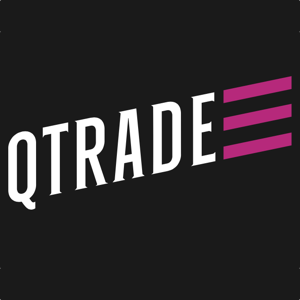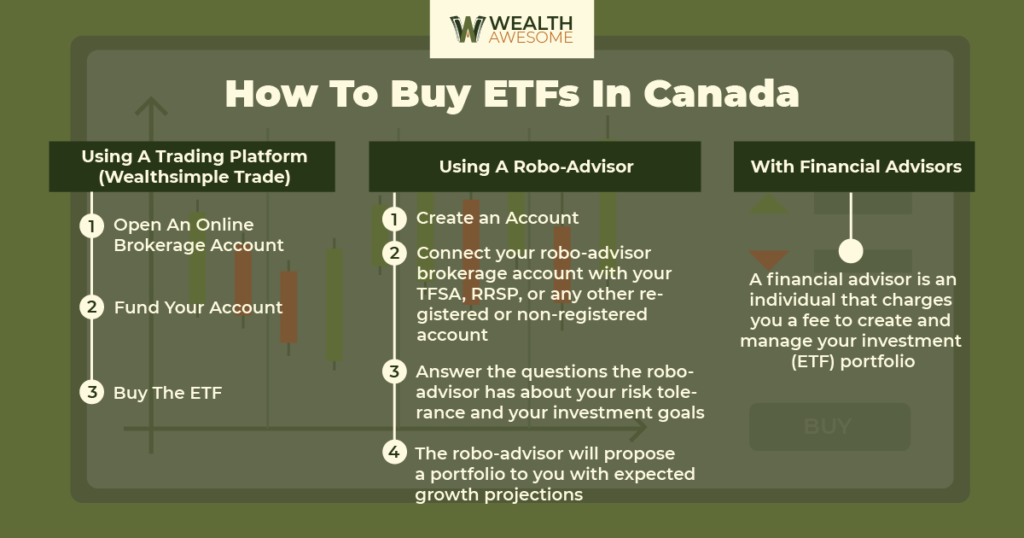So you’ve read about exchange-traded funds (ETFs) and have decided that you want to buy them. What are your options?
If you are worried that learning how to buy ETFs in Canada will be a complicated or gruelling process, don’t be!
I prepared this guide to inform you about the tools and overall process. If you follow the steps, you’ll have no trouble buying and creating your first ETF portfolio, either by building your own or using a robo-advisor.
Canadians have invested over $1.8 trillion into ETFs by the end of 2022, and if you want to learn how to buy this popular investment, read on.
How To Buy ETFs In Canada with a Trading Platform
Using a trading platform gives you the ultimate control and flexibility in buying your ETFs.
Step 1: Define Your Investment Goals and Asset Mix
Outline what your financial goals and time horizon for these investments will be. Do you want to save for retirement, a house, or a vacation? When will you need to withdraw the money?
Then figure out your risk tolerance and proper portfolio asset mix. You can do this using a resource such as this Vanguard investor questionnaire. This is very important because you’ll need to figure out what percentage of fixed income vs equity you should purchase.
Step 2: Select the ETFs You Will be Buying
Start by researching different types of ETFs. You can start by going to websites from providers such as Vanguard or iShares and see what they are offering. Another way to get started is using a stock or ETF screener.
You can use this to filter your ETFs for things like asset class, company, AUM, fees, and more. You can also check out lists of top ETF picks, which can help narrow down your options.
After you have a short list of ETFs you might be interested in buying, you can dig deeper into each one. Start with the ETF Facts sheet that will give you a quick overview of things like performance, fees, objectives, top holdings, and risk rating.
If you want to really go in-depth, you can examine the ETF prospectus, which outlines things like management strategy, outlook, tax information and liquidity.
Here’s a streamlined approach:
- Understand Your Investment Goals: Are you aiming for growth, income, or a mix of both? Your investment objective will guide your ETF selection.
- Diversify: Opt for ETFs that give you exposure to different asset classes, sectors, and geographies. Diversification can help mitigate risks.
- Research the ETF Provider: Reputable providers like Vanguard, BlackRock (iShares), and others often offer more reliable and well-managed funds.
- Examine the Expense Ratio: The expense ratio represents the annual fee that all funds charge their shareholders. An ETF with a lower expense ratio will eat up less of your returns over time.
- Check Liquidity: Ensure that the ETF you’re considering trades with good volume, which generally results in tighter bid-ask spreads and fewer price discrepancies.
- Performance History: While past performance doesn’t guarantee future results, it can give you a sense of how the ETF reacts to different market conditions.
- Underlying Assets: Understand what assets the ETF holds. This will help in understanding its volatility, growth potential, and risk.
All-In-One vs. Building Your Own ETF Portfolio
There are two main strategies for selecting your ETFs. You can go the easy route, which is to simply buy an all-in-one ETF portfolio that matches your proper asset mix. This won’t require much research or investment knowledge and is a popular choice for many Canadians. The downside is that the fees will be slightly higher than creating your own ETF portfolio.
To build your own ETF portfolio, you will select a combination of equity and fixed-income ETFs that matches your proper asset mix. This will involve more research and time for rebalancing and maintenance, but it will be the cheaper way to build an ETF portfolio.
Step 3: Open A Trading Platform Account
There are plenty of online trading platforms that allow you to buy and sell ETFs. Some factors you should consider before choosing your trading platform are:
- Fees and commissions – compare costs of things like trading commissions, account opening fees, and account maintenance fees.
- Customer support – see if their service is highly rated and has good reviews.
- Account types – ensure the company offers the account types that you are interested in
- ETF types – make sure the ETFs you are interested in can be purchased on the platform
You can simply follow the steps when to signing up for the trading platform. Here are our top picks for trading platforms in Canada:

- 105 commission-free ETFs to buy and sell
- Excellent customer service
- Top-notch market research tools
- Easy-to-use and stable platform

- Stock and ETF buys and sells have $0 trading fees
- Desktop and mobile trading
- Reputable fintech company
- Fractional shares available
Related Reading: Best trading platforms in Canada.
Step 4: Fund Your Account
You can transfer money to your brokerage account using various methods, such as Electronic Funds Transfer (EFT) directly from your bank account, a wire transfer, or bill payment. Funding times will vary depending on the brokerage and the funding method.
Additionally, you can set up automatic withdrawals, so a set amount of money falls into your brokerage account at a pre-decided frequency (for example, $500 every month in your TFSA-linked account).
Step 5: Place an Order to Buy the ETF
Here comes the fun part, which is to actually buy the ETF on the platform. You will need to place a trade order to buy an ETF. There are two main types of orders: market orders and limit orders.
A market order will execute at the best available price, while a limit order allows you to set a specific price at which you’re willing to buy the ETF.
Example: If you want to buy 100 shares of iShares S&P/TSX 60 Index ETF (XIU) using a limit order at a price of $25 per share, you would enter the following order details:
- Order type: Limit order
- Ticker symbol: XIU
- Quantity: 100 shares
- Limit price: $25
- Duration: Day or Good-Till-Cancelled (GTC)
Double-check the order details, including the ticker symbol, order type, quantity, and price, to ensure accuracy. Once you are confident in the order, submit it for execution. You should get a notification that the purchase has been successful, and now see the shares in your trading account.
Step 6: Monitor your investments
After your order has been executed, monitor your ETF investments regularly. Keep an eye on their performance and market conditions. Rebalance your portfolio at least once a year to maintain your desired asset allocation.
How To Buy ETFs In Canada Using A Robo-Advisor
The process of buying ETFs with a robo-advisor is relatively simple:
- Create an account. You’ll need to provide and verify your personal and financial details.
- Connect your robo-advisor brokerage account with your TFSA, RRSP, or any other registered or non-registered account.
- Answer the questions the robo-advisor has about your risk tolerance and your investment goals. It will create a portfolio for you that will fall into one of the portfolio categories (growth, conservative, etc.). Usually, conservative portfolios have a different “equity” to “fixed income” ETF split compared to growth portfolios. Growth portfolios have more equity ETFs, and conservative portfolios have more fixed-income ETFs.
- The robo-advisor will propose a portfolio to you (made up of ETFs) with expected growth projections (based on the timeline relevant to your investment goals).
It’s important to note that when you are working with a robo-advisor, you don’t have control over which ETFs you are going to buy. Most robo-advisors work with a select basket of ETFs and might not expose you to the full range of ETFs you can buy on your own.
The only choice you really have to make is to select which portfolio and asset mix you want based on your risk profile. If you need help figuring that out, the robo-advisors’ customer service can walk you through it.
Similarly, compared to buying ETFs on your own using a trading platform, buying them through a robo-advisor actually costs you money. If it charges 0.5% of the portfolio value, you will pay $250 a year for a $50,000 TFSA portfolio.
Why then would robo-advisors be a good route to ETF investment? Because it doesn’t require you to research individual ETFs and develop the necessary investment knowledge on your own. The robo-advisor offers completely hands-off investing.
Which Robo-Advisor to Choose
I’ve done an in-depth review of robo-advisors in Canada, and here are my top picks:
- Lowest Fees by a Wide Margin
- Actively Managed Portfolios
- Online Live Chat Support
- Tax-Loss Harvesting
- Reputable Questrade Brand
- Best Overall Products
- Most Assets Under Management
- Reputable Brand
- SRI and Halal Investing Options
- Beautiful Design
Should You Choose Robo-advisor or Trading Platforms?
Both of these methods attempt to do more or less the same thing: construct an ETF portfolio and provide diversification.
Most robo-advisors charge at least a 0.40% fee on top of the management expense ratio (MER), so your total yearly cost should be around 0.55%-0.70%. This is almost double, or even triple the cost of using a trading platform.
| Method | Difficulty of Setting Up | Fees (All-In) | Customizable |
| Robo-Advisor | Easy | 0.55% – 0.7% / Year | No |
| All-In-One ETF Portfolios (Trading Platform) | Easy | 0.20% – 0.30% / Year | No |
| Portfolio of Multiple ETFs (Trading Platform) | Medium | 0.13% – 0.20% / Year | Yes |
Hiring a Financial Advisor to Buy ETFs
There’s a third way to buy ETFs, but I wouldn’t recommend it. It is to hire a discretionary financial advisor who will buy and sell ETFs for you.
But they are also expected to charge a fee that will likely be significantly higher than what you might pay with robo-advisors or building your own ETF, typically in the 1-2% range per year. If you have a $100,000 portfolio, that would be equal to $1,000 – $2,000 you’d be paying them every year.
If you understand how that particular asset works and know how to analyze different ETFs, you will probably be better off creating and managing your own portfolio, or buying an all-in-one ETF portfolio yourself and save on the fees.
ETFs vs Mutual Funds
ETFs are known for their lower fees, greater tax efficiency, and intraday trading capabilities, while mutual funds offer professional management, automatic reinvestment, and simplified access to diversified portfolios.
The main argument for mutual funds is that it offers active management, which in theory it is supposed to protect you against downside risk more and can potentially beat the market, while ETFs will never beat the market and will just track it.
The problem with that argument is that mutual funds on average vastly underperform the market. As an example, 93% of Canadian equity mutual funds have underperformed the market over a 5-year period ending in 2022, according to SPIVA. This is likely due to Canadian mutual funds’ extremely high fees.
Because ETF fees are so cheap, if they properly track the market, it has a high potential to lead to better returns than mutual funds in the long run.

Types of ETFs
ETFs are versatile and can be categorized based on several factors. Make sure you choose the right ones for your needs:
- Asset Class:
- Equity ETFs: Track specific stock indices, sectors, or styles.
- Fixed-Income ETFs: Track and invest in bonds.
- Commodity ETFs: Invest in commodities like gold, oil, or agricultural products.
- Currency ETFs: Aim to track foreign currencies.
- Real Estate ETFs: Invest in real estate investment trusts or companies in the real estate sector.
- Investment Strategy:
- Growth ETFs: Aim to invest in stocks of companies expected to grow at an above-average rate.
- Value ETFs: Focus on stocks that are considered undervalued.
- Factor-Based ETFs: Rely on specific characteristics or factors such as momentum or quality.
- Geographic Focus:
- Domestic ETFs: Invest primarily in Canadian-based assets.
- International ETFs: Focus on assets outside of Canada, possibly focusing on specific regions or countries.
- Emerging Markets ETFs: Invest in countries with emerging economies.
- Specialty and Thematic ETFs: Focus on niche market segments or themes, like renewable energy or artificial intelligence.
- Leveraged and Inverse ETFs: These use financial derivatives and debt to amplify the returns of an underlying index or employ strategies to profit from asset declines.
Conclusion
ETFs have been a game-changing investment asset class right from the beginning.
They are set on a path to replace mutual funds as the most popular investment in Canada, are the core asset class for robo-advisors, and are preferred over individual stocks by many investors (thanks mostly because of their diversification and ease of use).
But to get the best out of ETFs and to make an ideal portfolio for your investment goals (and risk tolerance), it’s important that you learn more than just how to buy ETFs in Canada.
You should learn about different ETF providers, and different ETFs to develop your own ETF selection criteria.
Learn about one of the easiest ways to invest in ETFs, which is by using Vanguard’s all-in-one ETF series.






can you pls put forth suggestions to which ETFS are best for TFSA’s and RESP’s, as i understand there are different tax implications for those versus RRSP’s
Many thanks
Take a look at this article, I think it holds your answers, but read it carefully including the link to the Vanguard PDF: https://wealthawesome.com/best-etfs-for-tfsa/
thank you for your information! We are a retired couple who just sold a house and have found that we can’t add any money to our RIFs, and we don’t have enough capital for a securities outfit to take us on without combining our RIF investments with the small capital gain from selling the house. We are US expats and face some serious tax consequences if we invest in mutual funds — so learning about ETFs will be our next step. We felt a bit stranded, but now, thanks to your info, feel a little less so!
Having mistakenly trusted the folks at Sunlife Canada to take care of my DCPP, have to educate & take charge of my DCPP or retirement will be pretty dismal.
Have bookmarked your site. Find it easy to follow & yes, was feeling overwhelmed, now feeling hopeful – I can do this!
Still have a long way to go.
Thank you Christopher Liew
You’re welcome Lynn! Glad you enjoy the content and find it helpful
This is very good web site, it contain a lot investment information for the beginner like me
Glad you like it Ralph!